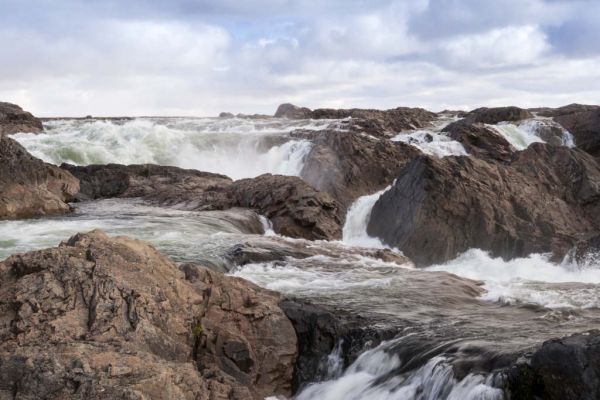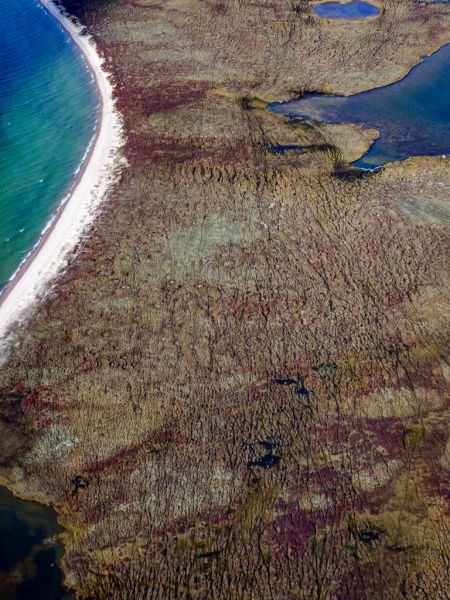The Canadian River Heritage Award is one of the most prestigious awards recognizing river conservation and promotion in Canada. It is given every two years to an individual for steadfast commitment in conserving or promoting Canada’s fresh water heritage. The CHRS and the Canadian Canoe Museum have come together to promote and present this award in hopes of broadening and extending the network that we reach.
Nominations are due June 30th, 2021.
Help us get the word out to your networks. Please circulate the link to our webpage and share our social media posts on your pages.
Visit https://chrs.ca/en/awards to learn more.
CHRS Newsletter - Spring 2021
Looking for Water Champions! Help us spread the word.
by: Canadian Heritage Rivers Secretariat
2017-2020 Canadian River Heritage Awards - Part III
by: Canadian Heritage Rivers Secretariat
The Canadian River Stewardship Awards are presented every three years to individuals and organizations who have made a significant contribution to the stewardship of a Canadian Heritage River or to the Canadian Heritage Rivers System program as a whole.
Three outstanding individuals received a Canadian River Stewardship Award for 2017-2020:
- Clarence Ryan for his work as the Chair of the Pisquid River Enhancement Project (PEI);
- Geoff Bowie and partners for their work on the film: South Nahanni: River of Forgiveness (NWT); and
- Tracy Bond, for her work with the Baker Creek Enhancement Society (BC).
In this, and previous editions of the CHRS newsletter, we featured the invaluable contributions that these river guardians made for these rivers and celebrate their role in our past, present and future.
After the devastating 2017 wildfires along the Fraser River Plateau in the interior of British Columbia, and subsequent landslides and flooding, it will take decades of work to stabilize and recover the watershed.
Tracy Bond and the Baker Creek Enhancement Society’s long-term watershed impacts on both salmon and local communities are admirable. Tracy’s assessment, organization and response were unprecedented. She raised resources for restoration efforts that brought her community together in healing and connecting to the river. Tracy’s project, in partnership with the Nazko First Nation, will hopefully help to change approaches to wildfire response for other watersheds in the future.
The Harvaqtuuq and Akillinik - Celebrating 30 years as Canadian Heritage Rivers!
by: Paula Kigjugalik Hughson, TPC Member for Nunavut
The Harvaqtuuq (Kazan River) and Akillinik (Thelon River) were designated as Canadian Heritage Rivers in 1990, making 2020 the year of their 30th anniversary.

In July 1990, in recognition of its natural, cultural and recreational values, a 615 km section of the Harvaqtuuq was designated a Canadian Heritage River. The designation was based on the river’s unique boreal landscape and the role it plays in the migration route of the Qamanirjuaq caribou herd, the largest movement of land mammals in the world.
In the same year, the Akillinik was also designated to the Canadian Heritage Rivers System. The Thelon is a boreal-Arctic oasis that supports a rich and unusually diverse northern concentration of wildlife. A 545 km stretch of this 940 km river was designated to the Canadian Heritage Rivers System for its natural, cultural and recreational values. Both designations were in recognition of the Caribou Inuit’s strong desire to have the rivers and their traditional life on them commemorated by all of Canada.
The collaboration of all parties and local people make these designations a great success because they’re all about the rivers and their story. As this story evolves, it helps keep our past, present and future alive. The Harvaqtuuq and Akillinik are important to the community of Baker Lake and the region.
7 Facts about Harvaqtuuq (Kazan River) that will make you say ‘Huh, Interesting!’
by: Paula Kigjugalik Hughson, TPC Member for Nunavut

- Geology-wise, the Kazan River cuts through the oldest rocks on earth.
- Caribou from the Beverly and Qamanirjuaq Caribou herds cross the Kazan River many times and provide nutritional food for the Inuit of the area. This area is an important habitat for calving, post calving, and nurturing the caribou from their migration from their southern staging areas of northern Saskatchewan and Manitoba.
- The Harvaqturmiut; People of the lower Kazan River who originally occupied this landscape now have descendants in the hamlets of the Kivalliq region. Baker Lake is where the majority of the Harvarturmiut population relocated to when the federal government made settlements in the region.
- “Fall Caribou Crossing National Historic Site” is located along the Kazan River and was initiated by local elders of Baker Lake. The plaque is located at the Itsarnitaqarvik - Inuit Heritage Centre in Baker Lake.
- In 1770, Samuel Hearne was the first European to enter the area. In 1868 Father Gaste, a Catholic priest, was first to travel to this area to spread the word of God. In 1894, Joseph Burr Tyrell was the first southern Canadian and scientist to travel the Kazan. In 1921-23 Knud Rasmeussen travelled in this area and documented many names of Inuit who lived in the area.
- In recent history the area has been “re-discovered” by mineral exploration companies. Today this area is known for its uranium potential. Various companies have staked claims in this area over the years.
- The Kazan river is still a very active area for people of Baker Lake where they hunt caribou or go camp at their ancestral campsites or to enjoy what the land has to offer; peace, solitude and rejuvenation of their soul.
7 Facts about Akillinik (Thelon River) that will make you say ‘Huh, Interesting!’
by: Paula Kigjugalik Hughson, TPC Member for Nunavut
- The Thelon Wildlife Sanctuary was established in 1927, and contains the Arctic Oasis, where the confluence of different wildlife and diverse habitats are found, including: caribou, muskoxen, moose, and a tundra/ boreal transition in vegetation and habitats.
- The Akillinirmiut; people of Beverly Lake area and Qairngnirmiut; dwellers of a flat land; Inuit have lived along and around the Thelon River system for generations until they were to permanently move to settlements such as Baker Lake.
- Ancient archaeological sites are prevalent and show their importance to all cultures who lived in the area.
- Researchers came to this area because of the ill-fated crew in 1927 of John Hornby, for which the Thelon Wildlife Sanctuary was created, with the information initiated by them. Between 1928 to the 1960s, researchers such as W.H.B. Hoare, C.H.D. Clarke, J.P. Kelsall, J.S. Tener and E. Kyut came to learn about and document the area.
- Numerous recreational canoeists from all over the world have come to paddle the Thelon River. One such advocate for this river was the late Alex Hall who paddled the river 99 times in his lifetime!
- Mineral exploration companies have been interested in this area for years, and even more so when it was discovered there was uranium nearby. It took the falling of a Russian satellite from space to learn that the land was rich in uranium!
- The community of Baker Lake was instrumental in holding a plebiscite vote in the early 1990s where the community was asked if they wanted uranium exploration/mining in their backyard. The answer was 90% No. These issues, and many like these where Inuit rights were infringed, sparked the Nunavut Land Claims process and led the people of Baker Lake to stand up and question those in power at the time.
Meet some Thelon and Kazan River Stewards
by: Paula Kigjugalik Hughson, TPC Member for Nunavut
In 1989, the Hamlet of Baker Lake with the support of the local community along with the Government of the Northwest Territories - Economic Development and Tourism Division and Government of Canada-Department of Indian and Northern Development submitted a Nomination Document for the Kazan and the Thelon Rivers to become Heritage Rivers. This brought about the conversion of the old Hudson’s Bay Store in Baker Lake to be made into a seasonal visitors’ center: the Vera Akumalik Visitors Center. The Inuujaarvik Territorial Park (Campground) is located between the local airport and community, the main users of this site are the canoeists who paddle the Kazan or Thelon Rivers.
In 2019, Nunavut Tunngavik Incorporated, Kitikmeot Inuit Association, Kivalliq Inuit Association, Qikiqtani Inuit Association, the Government of Canada – Indian Affairs and Northern Development and Government of Nunavut – Department of Environment signed an Umbrella Inuit Impact and Benefit Agreement for the Canadian Heritage Rivers in Nunavut.
While the management of the Heritage Rivers continues to evolve in Nunavut, local grassroots-level involvement and support remains key. Heritage Rivers are important to the people who have ancestral ties, homelands, campsites and hunting grounds along these rivers and want these areas celebrated and highlighted for all to see, experience and enjoy.
Meet the CHRS River Manager: Paula Kigjugalik Hughson
by: Paula Kigjugalik Hughson, TPC Member for Nunavut
My name is Paula Kigjugalik Hughson and I am currently the Coordinator - Heritage Rivers Planning and Management with the Government of Nunavut, Department of Environment, Parks and Special Places Division and I am responsible for the three Heritage Rivers plus one nominated river in Nunavut.
This position recently moved in 2020 from Rankin Inlet to Baker Lake NU, where two Heritage rivers are designated: Kazan and Thelon Rivers.
Prior to this position, I have been to the Kazan Falls and part way up the Thelon rivers by motorized boat with my uncle Victor and his wife. We saw some lone muskoxen and caribou along the shoreline, peregrine falcons, glaucous gulls, Lapland long spurs, and when we rodded along the shores we caught trout or grayling.
My mom’s family prior to moving to the settlement of Baker Lake in the mid 60’s lived off the land and lakes and rivers. They had seasonal camps and lived at Aberdeen Lake, Schultz Lake and between Kazan and Thelon Rivers. They hunted for caribou, fished the lakes and rivers and hunted small game and waterfowls, using skins and bones for clothes and tools. They trapped foxes and were able to buy guns and ammunition, flour, sugar, tea, canoes and motors with the pelts they traded at the Hudson Bay Store in Baker Lake, now the Vera Akumalik Visitors Centre, which houses the Thelon River Plaque. I was honoured and grateful to obtain my Master’s thesis in 2010 which documented a way of life retold by my late uncle John Killulark of their homeland: Aberdeen Lake and Schultz Lake landscapes, which are a part of the Thelon River system.